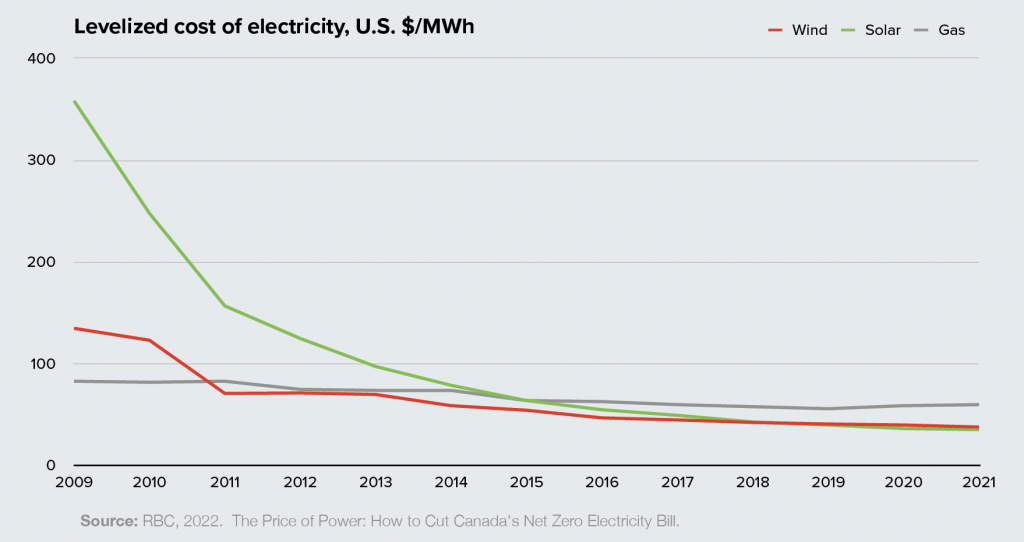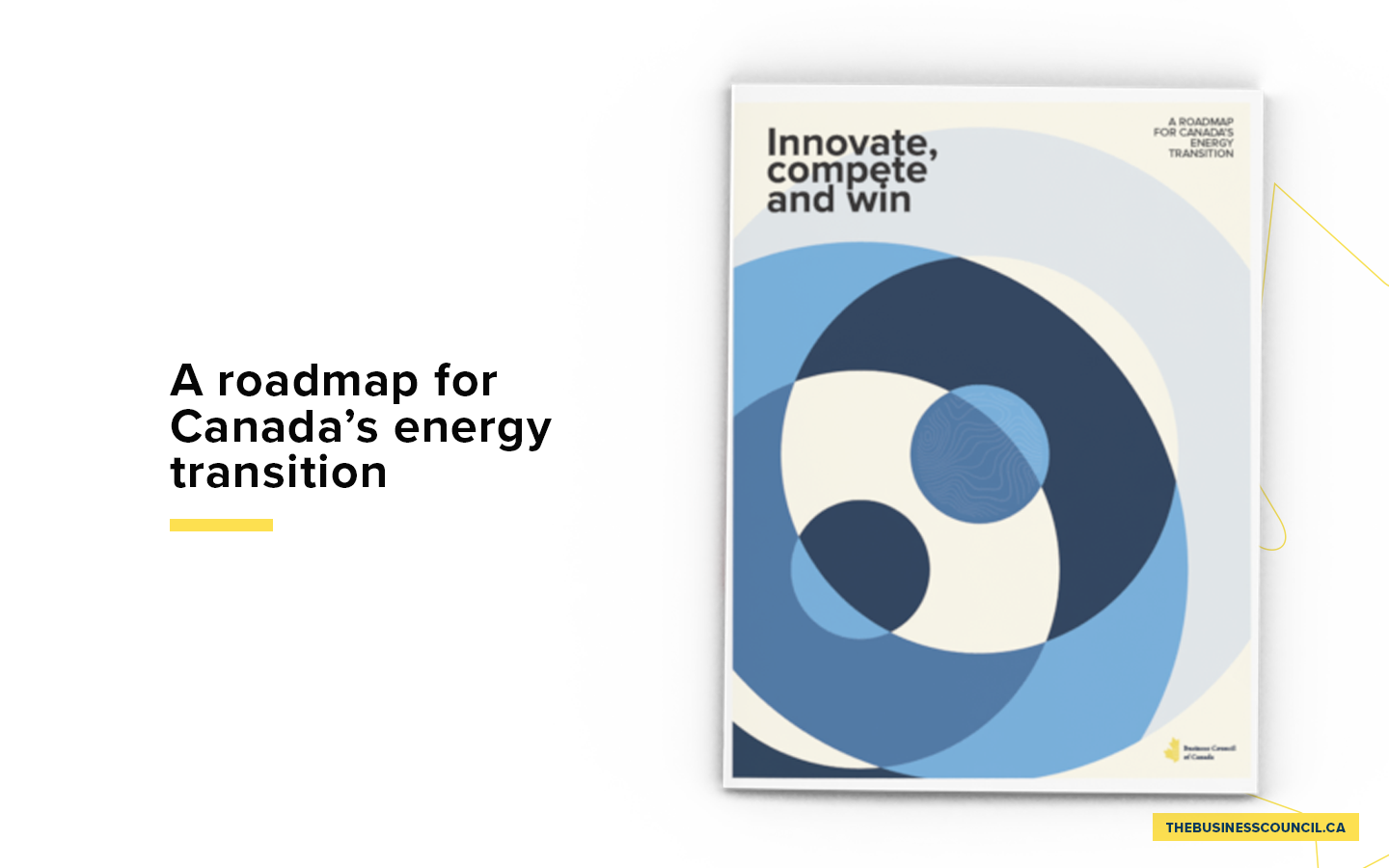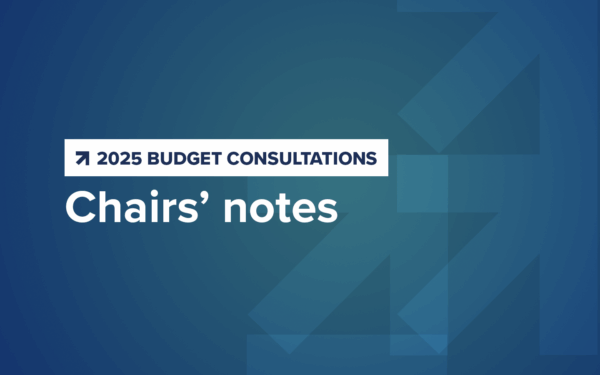Innovate, compete and win
A roadmap for Canada's energy transition
Executive summary
Climate change is one of the greatest challenges of our time. Canada will not be able to achieve its ambitious climate change goals, however, unless it has a comprehensive energy transition plan. Immediate action and substantial capital investment are required to meaningfully lower emissions and invest in lower carbon energy solutions that will position the country for long-term success. Yet much of that required capital is currently sitting on the sidelines as corporations face an uncertain regulatory and policy environment which discourages investment in the energy systems that will allow Canadians to thrive in a lower-carbon future.
Canada urgently needs a coherent climate and economic policy agenda to ensure a rapid deployment of low-carbon capital and technology. Our companies and policy makers proved during the pandemic that they could react with speed and dexterity, and that effective programs could be set up quickly and adapt to changing conditions and new information. We need that drive and nimbleness now more than ever.
Canada’s role in bolstering global energy security
The war in Ukraine has put an additional spotlight on energy security, as many countries struggle to cope with a rapid run-up in energy prices and — in some cases — to keep the lights on. Our climate ambitions cannot be separated from the domestic and global need for secure sources of affordable energy. As Deputy Prime Minister Chrystia Freeland has noted, energy security is now clearly tied to national and economic security. We believe there is both an economic and moral imperative for
Canada to use our resources to help our most important allies in their time of need.
Canada can be a leader in contributing responsibly produced energy to global markets in the form of liquefied natural gas (LNG), uranium/nuclear and in time, hydrogen. This could both ease short-term energy security challenges for our allies and reduce global reliance on higher-emissions sources of power.
The federal government must clearly articulate its intention to have Canada make a significant contribution to global energy security and outline specific measures it will undertake to expedite the approval of further development of Canadian LNG, other low-carbon energy sources and related infrastructure.
Maintaining a level playing field with our largest trading partner
While governments at all levels have advanced foundational pieces to support Canada’s energy evolution, what is missing is a sense of urgency. Other countries are moving faster to attract the technologies and investments that will power the coming economic and energy transformation. With the tectonic shift that is the Inflation Reduction Act, the U.S. has signaled that climate policy is also economic security policy. And they have opted for market incentives for investment in climate solutions rather than prescriptive regulation. Without an adequate Canadian response, we risk standing by while valuable human and financial capital moves to greener pastures south of the border.
Budget 2023 must respond effectively to the competitive challenge of the U.S. Inflation Reduction Act with commensurate measures to support industries and technologies that will enable domestic decarbonization and position Canada for international success.
Policy clarity and predictability
Financial and market certainty. We have a mere seven years to reach the ambitious federal 2030 target for greenhouse gas (GHG) reductions. Without a coherent policy agenda aimed at deploying capital at speed and scale, Canada may fall short of our climate targets and miss out on the emerging net-zero economic opportunities. This could in turn weaken the country’s competitiveness and ability to create the highly skilled and well-paid jobs of the future. The policy focus should be on incenting higher levels of investment and identifying ways to improve project economics rather than developing new regulations or taxes, which add complexity and delay final investment decisions.
The federal government must:
- Create policy clarity, certainty and longer-term predictability for the industries leading the net-zero transition.
- Ensure carbon pricing policy is attuned to the competitive realities of Canada’s emissions-intensive and trade-exposed industries and build a robust market for carbon credits.
- Develop a broader suite of investment and production tax credits to incent investment in major emissions reduction projects.
Regulatory coherence. Given the scale of the net-zero challenge, we urgently need to restore Canada’s reputation as an attractive place to invest in low-carbon solutions and as a country that can get big projects built. The Prime Minister, Deputy Prime Minister and Minister of Natural Resources have all recognized the need to shorten the timelines for approval of low-emissions projects. This should include projects that are in the national interest and meet one or more of the following criteria:
- Increase Canada’s contribution to global energy security;
- Ability to substitute Canadian products for more GHG-intensive options in importing countries;
- Low-carbon fuel production (e.g. hydrogen, renewable natural gas, biofuels and uranium);
- Electricity transmission within and between provinces resulting in a net decrease in GHGs.
- Low-carbon electricity generation (e.g., renewables, nuclear, storage, pumped hydro);
- Critical mineral mining and processing facilities; and
- Projects which are Indigenous-led, have an Indigenous ownership component, or have Indigenous support based on early engagement by the proponent.
The federal government must use Budget 2023 to enhance the efficacy and efficiency of the assessment process and shorten the timelines for approval of projects that will make a demonstrably positive contribution to Canada’s climate and economic goals.
The federal government should empower the Privy Council Office with a mandate to ensure ongoing coordination amongst relevant departments and the Impact Assessment Agency in order to maximize efficiencies and quickly address barriers to completing assessments for major projects.
A supportive innovation ecosystem. Technological change is the key to addressing climate change without compromising economic growth and living standards. However, catalyzing breakthrough ideas and technologies and then transforming them into commercial opportunities requires a shift in policy focus. The federal government recently added the $15 billion Canada Growth Fund to the existing array of funding and technology progams (SIF, NZA, CIB, SDTC, etc.) as well as financial commitments associated with specfic sector strategies (critical minerals, hydrogen, SMRs, etc.). It also is creating a new innovation agency to help commercialize research and advance new economic opportunities. The sum total allocated for clean technology is signficant, but what is lacking is a coherent overall strategy.
The federal government should rationalize existing clean technology support programs, pool resources and make bigger bets on a smaller number of key innovations that have the best chance to maximize climate benefits and/or return on investment.
The government’s new innovation agency should be independent and given a mandate that parallels that of U.S. ARPA-E, i.e., bringing together the best public and private research, as well as pursuing the most promising opportunities to scale up/commercialize low-carbon technologies and products.
Empowering Indigenous economic reconciliation
Indigenous communities understandably want a larger voice regarding economic development that takes place on or near their communities and how they can share in the benefits. Canada’s business leaders recognize this, and many are building stronger relationships/partnerships to expand opportunities for Indigenous Peoples. However, barriers remain to enabling Indigenous communities to partner in development projects, most notably their access to risk capital and traditional lending.
The federal government should establish a national loan guarantee program to support Indigenous access to capital for equity partnerships in natural resource projects.
Building the electricity grid of the future
The federal government has set an ambitious goal of a net-zero electricity grid by 2035 and net zero emissions nationally by 2050. That suggests at least a doubling of current electricity capacity. In addition, it must be done in a way that maintains grid security, reliability and affordability. That can only be accomplished by recognizing provincial jurisdiction, creating incentives for grid modernization and working with electricity providers on new technologies such as hydrogen and energy storage. The required expansion of electricity capacity cannot be accomplished by public dollars alone; governments will have to encourage much greater private sector investment.
The federal government must work cooperatively with the provinces to support the build-out of grid capacity and through facilitating substantially greater private sector investment in electricity generation and transmission.
The federal government must deliver a predictable and technology-neutral set of investment tax credits to encourage the investment required to generate, transmit, and distribute, the scale of clean generation necessary to meet Canada’s climate goals.
Critical minerals
Canada has impressive reserves of several critical minerals that will power the net-zero transition. But the global race is heating up and other countries are not standing still. The federal critical minerals strategy is an important step. But it needs to transform into a truly national strategy focused on mining and processing of minerals and establishing strong linkages to North American and global supply chains.
The federal government must work with the provinces to develop a national strategy to capitalize on our world-class reserves and mining expertise and position us to be a key global provider of critical minerals. This includes a plan to develop the infrastructure to support mines and processing facilities in remote locations and a commitment to fast-track the approvals for such projects.
Low-carbon oil and gas
All credible scenarios suggest the world will need fossil fuels for several more decades. With its ESG credentials and commitments to invest in GHG-reducing technologies, the Canadian energy industry can compete to retain, and even expand, its share of that market. The proposed cap on the sector’s emissions must be designed with flexibility to ensure it actually stimulates new emissions reduction projects and does not merely curtail oil and gas production. The current uncertainty over the specific cap and the design of the policy risks delaying needed investment and puts our climate targets at risk.
The federal government must work cooperatively with the oil and gas industry to establish a downward emissions trajectory to 2030 and 2050 that is economically and technically feasible. They should also agree on a policy framework that would support the required technology investment.
Electric vehicles
Canada must solidify its position in the rapidly expanding North American electric vehicle (EV) industry and ensure an integrated continental supply chain for EVs, from critical mineral mining and processing, to battery elements and vehicle assembly and parts. Current EV policy is largely driven by a sales mandate to have 100 per cent of vehicles sold be zero-emission by 2035. But other policy drivers are urgently needed for the country to have any chance of meeting that target.
The federal government should work with the provinces to enhance purchase incentives for EVs, expand publicly funded charging infrastructure as well as create incentives for installation of home and commercial EV chargers. In light of the IRA, the federal government should review incentives and develop an overall strategy to attract domestic production of battery cells, modules and cathodes.
Introduction
Climate change is one of the greatest challenges of our time. Failure to act decisively will create significant long-term issues for our economy, our communities, and the quality of life for future generations. A coherent and effective response to the challenge can unleash significant economic opportunities that will position Canadian companies to compete in the low-carbon transition, create highly skilled and well-paid jobs and improve the prospects for reconciliation with the Indigenous Peoples of Canada.
A successful strategy to combat climate change requires a true partnership between the public and private sectors. Companies are designing their strategies to meet climate goals, encouraged by shareholders, regulators, employees and customers to demonstrate their societal responsibility and ensure their products and operations come with a lower carbon footprint. Many are ready to invest significant sums in transforming their business, but they face an uncertain policy environment and conflicting signals from all levels of government.
Estimates have put the scale of investment to achieve Canada’s net zero transition at $2 trillion, much of which will come from the private sector. In addition to companies reorienting their business plans toward a low-carbon future, immense amounts of capital are available through pension plans, financial institutions and private equity. But much of that capital is currently sitting on the sidelines, as investor uncertainty delays emissions reduction projects and blunts the incentive to develop sustainable technologies for export.
Time is not on our side – we have a mere seven years to reach the ambitious 2030 target for greenhouse gas (GHG) reductions set by the federal government. To their credit, governments at all levels have put some foundational pieces in place, but what is missing is a sense of urgency. Investors and project proponents do not have the policy clarity and longer-term predictability they need to confidently make the multi-billion-dollar investments that will be required. Other countries are quickly adopting policies to attract and deploy the technologies and investments that will power the coming economic and energy transformation. The U.S. Inflation Reduction Act is a game-changer. Without an adequate Canadian response, we risk valuable human and financial capital moving south of the border.
Our climate ambitions cannot be separated from the domestic and global need for secure sources of affordable energy. The war in Ukraine and the lingering effects of the global pandemic have put the spotlight on energy security. Countries around the world are struggling to cope with a rapid run-up in energy prices and – in some cases – to keep the lights on. This has in turn brought renewed attention to Canada’s global responsibilities. As Deputy Prime Minister Chrystia Freeland has noted, energy security is now clearly tied to national and economic security. We believe there is both an economic and a moral imperative for Canada to use its resources to help allies in their time of need.
The Business Council of Canada has long supported carbon pricing as an essential part of the climate toolbox. Likewise, we see an essential role for fair, responsive and efficient regulation to build public trust as we develop new infrastructure to support Canada’s energy transition. But the time has come to ask whether creating more and increasingly complex regulation is the right approach to further reduce emissions. An efficient regulatory system could be a competitive advantage for Canada. But it is long past time for a policy framework that is clearly set up to drive capital deployment with speed and scale.
A clean electricity grid can be a powerful competitive advantage and is key to the growth and decarbonization plans of many of our industries, including manufacturing, automobiles, steel, aluminum and critical minerals. Recent estimates suggest that Canada will require two to three times more electricity capacity to fulfill its net zero ambition by 2050.
Canada can be a leader in fueling the world with more sustainable forms of energy while also developing leading-edge climate solutions for domestic and global markets. But we face a very real risk that we will fall short of our climate targets and miss out on the economic opportunities from the net-zero transition. Canada urgently needs a coherent climate and economic policy agenda to ensure a rapid deployment of low-carbon capital and technology occurs over the next few years. Our companies and policy makers proved during the pandemic that they could react with speed and dexterity, and that effective programs could be set up quickly and adapt to changing conditions and new information. We need that drive and that nimbleness now more than ever.
As noted above, 2022 witnessed two fundamental shifts – global attention to energy security and the renewed focus by the United States on its domestic economic security – that greatly affect the choices Canada must make to navigate the clean energy transition. This paper outlines how we think Canada needs to respond to those two new drivers of change, and then outlines where urgent action is needed in a few areas that are critical to Canada’s economic, energy and climate security future.
Responding to new drivers of change
Canada’s role in bolstering global energy security
Energy price spikes and fears of rationing and blackouts have become headline news in some countries. European gas prices have eased somewhat recently, thanks in part to an extraordinary effort to obtain supply and the ramping up of LNG facilities in record time. But prices are still four to five times higher than what would normally be expected. This experience reminds us that energy systems are complex and attempts at rapid transformation can be painful when not coherently planned or in the face of unintended consequences. Indeed, they can impact climate goals, as some countries have had to resort to higher-emitting fuel sources in the short-term to prevent blackouts and/or contain public anger over spiking prices.
Canada could have been in a position to help its European allies with responsibly produced LNG. In August 2022 German Chancellor Olaf Scholz visited Canada with that request. But our failure to get government and industry alignment on building East Coast gas infrastructure meant that the Chancellor went home empty-handed. Most Canadians would agree that we have a moral obligation to help our allies. Accordingly, what is the appropriate role for Canada in strengthening global energy security and in ensuring a successful international response to the climate challenge? We believe Canada has the resources, the financial ingenuity and the human and technological capital to be a key player in the transition.
Even in a scenario where countries are aggressively pursuing decarbonization efforts and the world is on track to net zero emissions in 2050, the International Energy Agency (IEA) estimates that the world will still need fossil fuels. Their ‘Net Zero Emissions’ scenario suggests global demand of 77 million barrels of oil equivalent in 2030 and 24 million by 2050, down from about 100 million today. Natural gas demand is also likely to be strong for the next two decades as countries transition from higher-emissions sources of fuel. In addition, it plays a role as a necessary complement to renewables in electricity generation. As a world-leading sustainable producer of affordable natural gas, Canada should continue to compete for global market share. Canada already produces some of the cleanest natural gas in the world and has stringent regulations for methane. As well, major players in the oil sands have committed to net zero. They are making aggressive plans for carbon capture and are examining other decarbonization technologies, such as small modular reactors, to drastically reduce their emissions.
“The EU set a powerful example during the COVID pandemic, when European vaccine makers honoured their contracts with non-European allies. Canada must – and will – show similar generosity in fast-tracking, for example, the energy and mining projects our allies need to heat their homes and to manufacture electric vehicles.”
Hon. Chrystia Freeland, Speaking to the Brookings Institution, October 11. 2022
The investments we make today in natural gas infrastructure can become the flexible energy infrastructure of tomorrow. As countries around the world look to increasingly utilize clean-burning hydrogen, Canada is already one of the largest hydrogen producers and can capture more of this nascent market by ramping up investment in low-carbon hydrogen production and export. Our existing and emerging nuclear technologies, robust supply chains and uranium reserves also position us well to help countries develop zero-emissions electricity. And Canadian firms are eyeing significant investments in other low-carbon solutions, such as biofuels and renewable natural gas.
With aggressive investments in clean energy solutions, Canada can be a key player in the global energy transition, lowering global GHG emissions while powering new industries and resilient supply chains and creating a highly skilled work force. Our emerging clean energy advantage could also yield geopolitical influence, help create a more sustainable planet and assist the more than one billion people living without basic energy services. As other major energy suppliers – such as the United States, Australia and Norway – have demonstrated, there is no contradiction between contributing to global energy and economic security and the desire to reduce GHG emissions.
Several federal ministers have rightly pointed out that Canada needs a new strategy to ensure its economic and energy security. The concept of “friendshoring”, coined by U.S. Treasury Secretary Janet Yellen, reflects a desire to ensure supply chains, including energy and critical minerals, are more closely aligned with like-minded allies. Recent actions by Russia and China have demonstrated the wisdom of reducing reliance on autocratic countries seeking dominance in parts of the energy and materials supply chain in a way that is contrary to Canada’s interests.
Closer to home, we can work closely with the United States and Mexico to build on our diverse resource base and bolster continental energy security. Canada and the U.S. have world-leading nuclear technologies producing emissions-free baseload power and Canada has some of the lowest-emissions natural gas anywhere in the world. Together we can capitalize on growing global demand for lower carbon intensity energy and manufactured goods. Our countries can also benefit from close cooperation in developing innovative technologies – CCUS, hydrogen, biofuels, energy storage and small modular reactors.
Canada’s recently released Indo-Pacific Strategy recognizes the desire of countries in the region to obtain Canadian LNG, expand natural resource ties and mutually support the clean energy transition. Japanese and Korean government officials have made clear that their inability to source lower-emissions gas supplies threatens their domestic energy and climate objectives. And yet the Indo-Pacific Strategy says nothing about expanding Canadian energy export infrastructure to meet this growing demand. Also missing is any mention of nuclear power, notwithstanding our significant reserves of uranium, our nuclear and SMR technology and our expertise that could support Asia’s transition to cleaner electricity. Building the successful partnerships and trade relationships around Canadian LNG can strengthen Canada’s ability to export emerging low-carbon fuel sources and technologies in the future once they have evolved and matured.
Recommendation
The federal government must clearly articulate its intention to have Canada make a significant contribution to global energy security and outline specific measures it will undertake to expedite the approval of further development of Canadian LNG, other low-carbon energy sources and related infrastructure.
Maintaining a level playing field with our largest trading partner
Through the recent passage of the Bipartisan Infrastructure Act, the CHIPS and Science Act and the Inflation Reduction Act (IRA), the United States has committed more than $1 trillion (U.S.) to the creation of a “modern industrial strategy”. They have clearly signaled an intention to focus on manufacturing, clean tech, advanced computing, infrastructure and related workforce skills, all aimed at bolstering American competitiveness and countering China’s attempts to dominate certain critical market segments. They also are looking to work proactively with democratic allies in “friendshoring” critical supply chains. This is an important opportunity for Canada, but our privileged position in the continental market does not guarantee success if we are slow to act or fail to recognize the competitive implications of U.S. domestic economic realignment. And it is not just investment capital that may shift. The talent and technology that we need to prosper in the low-carbon economy could be drawn southward as well.
With the tectonic shift that is the IRA, the U.S. has clearly chosen the path of market incentives for investment in climate solutions rather than prescriptive regulation. Given the unlikely prospect of a meaningful national carbon price anytime soon in the United States, Canadian policy must be sensitive to the competitiveness implications for our most energy-intensive and trade-exposed industries. Business leaders continue to support a national carbon price in Canada, but we are price takers in the global market and Canadian firms must be competitive to be able to invest in low-carbon solutions.
We were pleased to see in the Fall Economic Statement (FES) that the federal government will consult with industry on the relevant portions of the IRA and how they could affect the competitive position of Canadian industry sectors. U.S. industry is already moving to take advantage of the IRA. For most sectors the IRA rules are simple and clear, offer more financially attractive incentives and over a longer period, than what is being planned or currently available in Canada.
One area of Canadian strength is hydrogen. The FES offers an investment tax credit of at least 40 per cent for the least carbon-intensive form of hydrogen production, compared to 30 per cent in the U.S. But the IRA also includes a production tax credit of up to $3 per kilogram for green hydrogen.
Both countries also have incentives for CCUS. Canada is proposing an investment tax credit of 50 per cent, beginning in 2023, but which is cut in half after 2030. The U.S. created a production tax credit for CCUS several years ago and the IRA increased it to $85 per tonne of carbon sequestered ($180 for direct air capture) and extended eligibility to 12 years.
Canada’s announced incentives and some of the investment tax credits lack the detail necessary for companies to make informed, long-term investment decisions. As well, several of the incentives disappear entirely or are sharply reduced post-2030, which will curtail investment since many of the biggest projects will take until 2030 to complete engineering and secure regulatory approval. We would not argue that Canada should attempt to match every aspect of the IRA. Rather, the strategy must focus on industries and technologies needed to meet Canada’s climate goals and — where Canada has obvious advantages abroad — ensure comparable incentives to maintain or strengthen that advantage. Given that most of the IRA incentives took effect January 1, 2023, it is critical that a targeted and effective Canadian response to the IRA be fully laid out in the 2023 federal budget.
Recommendation
Budget 2023 must respond effectively to the competitive challenge of the U.S. Inflation Reduction Act with commensurate measures to support industries and technologies that will enable domestic decarbonization and position Canada for international success.
A call for urgent action
Providing policy predictability for business
A. Financial and market certainty
The federal government’s goal of significantly reducing GHG emissions by 2030 and net zero emissions by 2050 will require a radical transformation in the way Canadians produce, transport, and consume energy. Research completed by the Royal Bank of Canada estimates that the total investment needed for Canada to transition to a net-zero future is $2 trillion. Budget 2022 estimates that between $125 and $140 billion of investment per year in green innovation and technologies will be required between now and 2050. However, current levels hover between $15 B to $25 B per year.
To its credit, the federal government has developed several important programs designed to incent higher levels of investment in Canada. The Strategic Innovation Fund’s Net Zero Accelerator, investment tax credits for CCUS, hydrogen and clean technologies, and a more pointed role for the Canada Infrastructure Bank are examples of federal efforts to accelerate such spending. While these programs are helpful, Canadian firms and investors need long-term policy predictability to support investments in emission reduction projects, which are typically capital intensive and involve payback periods that can span decades. Policy clarity also is critical to companies if they hope to maintain their global competitiveness in the low-carbon transition.
Canada’s carbon pricing regulation provides guidance up to 2030, but firms and investors require certainty over a much longer timeframe. Business leaders continue to support a national approach to pricing carbon emissions. However, complexity and uncertainty increase when new supply-side policies are introduced for specific industries. Of particular note are the Clean Fuel Regulation and forthcoming regulations designed to reduce emissions in the electricity and oil and gas sectors. Canadian firms and investors must wait and see how these requirements interact and influence their ability to attract capital. The net effect is to delay final investment decisions at a time when large-scale investments are urgently needed for Canada.

The government can also improve investment certainty by ensuring that its policies are aligned across multiple departments and portfolios. For example, Canada’s Greenbonds Framework excluded nuclear technology yet federal investments are flowing towards SMR projects in Canada. Further, differing eligibility requirements for investment tax credits and government grants create an unlevel playing field across technologies. The government can ensure the most efficient use of capital by creating a level playing field and allowing the most competitive solutions to emerge. The work currently being led by the federally appointed Sustainable Finance Action Council should focus on unlocking higher levels of investment in sustainably-produced energy of all kinds, including natural gas production and infrastructure.
To avoid carbon leakage, Canada’s carbon pricing regime must recognize that many other countries with which Canada competes in resource-intensive materials do not have correspondingly stringent GHG regulation, nor commitments to establish or enhance pricing mechanisms to close the gap. Additionally, the cost curves for Canadian low-carbon resource products, such as steel, cement, aluminum, uranium, and potash, remain high even as the carbon intensities of these products are world-leading. To date, it is unclear whether the market will pay a premium for low-emitting products.
Canada’s business leaders are committed to helping the government achieve its emissions reductions goals for 2030 and 2050 and are poised to invest billions over the coming decades. These investments require a deeper level of collaboration between the federal government and the private sector to improve investor confidence and scale up Canada’s most promising clean growth opportunities.
Our view is that policy makers need to urgently turn their attention to the following items:
Create fiscal instruments that support capital investment and operating expenditures in low carbon technologies of strategic significance to Canada
Recent decisions to create investment tax credits (ITCs) for clean energy and technology projects are positive and should be extended to a range of promising emission-reduction technologies. However, the design of the ITCs is narrowly focused on incenting upfront capital investments and not operating expenditures. A shift to creating revenue streams and supporting operational expenditures would improve project economics and maintain the competitiveness of Canadian firms. As well, credits currently focus predominantly on technology type, with some technologies being excluded (e.g., large-scale hydro power). An expansion in scope – taking an “all tools on the table” approach to decarbonization technologies – is needed to for Canada to achieve clean-economy and emissions-abatement objectives.
Through the Canada Growth Fund, the government is proposing a range of investment instruments to reduce both the risk created by carbon price uncertainty as well as costs for emerging clean technology projects. While details are lacking at this time, our view is that additional investment instruments will be necessary to incent investments in nascent low-emissions technologies which are high cost but have the potential to significantly lower greenhouse gas emissions. These instruments should be used to improve the ability of Canadian firms to compete in a global low-carbon economy.
Production tax credits are also important fiscal tools that can generate predictable revenues for major projects over a predetermined time frame. These tax credits are a cornerstone of U.S. climate policy but have yet to be explored in Canada. Doing so could help Canada level the playing field with the U.S. and improve the conditions for Canadian and foreign firms to invest in Canada. Used strategically, production tax credits can help firms make the investments necessary to reach climate goals as well as grow their market share in areas where Canada has comparative advantages: clean hydrogen production, carbon sequestration, critical minerals, manufacturing, and heavy industrial processes.
The Business Council agrees with the IEA that the transition to a low-carbon economy will require the use of all energy sources to be successful. Strong fiscal policies are required to develop and support technologies that are of strategic significance to Canada, using a technology-agnostic approach.
Ramp up Canada’s carbon credit market capacity
Canadian policy needs to evolve quickly from producing carbon credits to creating markets for credits. Without a robust market for both the demand and supply of credits, governments may be forced to increase stringency for emissions-intensive, trade-exposed sectors to maintain market balance. This can rapidly erode trade protection for key industries and reduce Canadian competitiveness. Companies with ambitious GHG reduction obligations require access to credible and reasonably priced domestic offsets as well as to the international emissions credit market.
Canada’s carbon credit market is still in its infancy and has been slow to mature. The federal government should move swiftly to develop protocols for generating offset credits for investments that reduce emissions produced by industrial processes in Canada. Federal and provincial governments can work together to assess the capacity and competitiveness of their respective offset systems and explore innovative ways to increase the pool of eligible credits for purchase by companies in Canada. The federal government also should work with allies internationally to ensure Article 6 of the Paris Agreement is implemented to secure a robust global trading system in carbon credits and that such system is transparent, economically efficient and environmentally credible.
Develop sectoral roadmaps and capital plans
As noted, Canada maintains several important programs and incentives to support clean growth opportunities. However, they are largely based on one-off applications by firms which can take months to be reviewed and approved by government officials. More fundamentally there is little evidence to suggest that they work within a coherent strategy designed to unlock the country’s most promising emissions reductions opportunities. Part of the solution is broad-based, technology-neutral support through ITCs and PTCs that allow companies to calibrate the level and duration of corresponding government investment.
A useful illustration of sector strategies is the recent “Roadmap to Net-Zero Carbon Concrete by 2050” signed by the federal government and the Cement Association of Canada. It will combine a focus on R&D, government support for major decarbonization projects, standards and skills development, as well as market development for Canadian low-carbon cement and concrete internationally.
Our view is consistent with the recommendations put forward by the Expert Panel on Sustainable Finance and numerous think tanks committed to ensuring a responsible transition in Canada. The country’s decarbonization efforts can be fast-tracked by developing sectoral roadmaps and policy instruments that support capital investment at critical junctures in the roadmaps. Such strategies could assess major economic and emissions-reduction opportunities, including a realistic timeline for significant decarbonization of the specific sector and competitive realities in global markets. They could serve to identify where business and government can co-invest in clean growth opportunities. They can be used to build a supportive policy environment for new market opportunities for clean technologies such as offshore wind. They can also be used to assess the potential for decarbonizing supply chains through new technologies and the low-carbon movement of goods.
Recommendations
The federal government must:
- Create policy clarity, certainty and longer-term predictability for industries leading the net-zero transition.
- Ensure carbon pricing policy is attuned to the competitive realities of Canada’s emissions-intensive and trade-exposed industries.
- Develop a broader suite of investment and production tax credits to incent investment in major emissions reduction projects.
- Work with the provinces and international allies to ensure a robust market for cost-effective, verifiable carbon credits.
- Collaborate with emissions-intensive industries to develop sectoral net-zero roadmaps that assess energy transition opportunities and develop corresponding capital investment and technology support plans.
B. Regulatory coherence
We sense a growing consensus amongst leaders in business, public policy and the environmental community that Canada’s regulatory approval processes have become unduly long and cumbersome. Federally appointed bodies, such as the Barton Growth Council, the Economic Strategy Tables and the External Advisory Committee on Regulatory Competitiveness, have repeatedly referred to the benefits of ensuring that our regulatory system is stringent, predictable, flexible and efficient. Regulatory “business-as-usual” means that many positive decarbonization efforts will take far too long to get built. This will compromise the country’s ability to meet the ambitious 2030 GHG reduction goal and realize the economic opportunities associated with clean energy and innovative decarbonization technologies.
Prime Minister Justin Trudeau, Deputy Prime Minister Chrystia Freeland and Natural Resources Minister Jonathan Wilkinson have all committed to shortening approval times for resource development and infrastructure projects. There is a case for fast-tracking projects that are in the national interest and meet one or more of the following criteria:
- contribution to global energy security;
- ability to substitute Canadian products for more GHG-intensive options in importing countries;
- low-carbon fuel production (e.g., hydrogen, renewable natural gas, biofuels and uranium);
- electricity transmission within and between provinces that would lead to a net decrease in GHGs;
- development of low-carbon electricity (e.g., renewables, nuclear, battery storage, pumped hydro);
- critical mineral mining and processing facilities;
- projects which are Indigenous-led, have an Indigenous ownership component, or have Indigenous support based on early engagement by the proponent.
The FES announced further resources for the Impact Assessment Agency (the Agency) and other federal departments with oversight responsibilities. That is positive but inadequate. The government should use Budget 2023 to establish a comprehensive plan to improve the efficacy of the assessment process and shorten the timelines for approval of demonstrably beneficial projects. Given the multi-billion-dollar scale of the net-zero challenge, we need to restore investor confidence in the attractiveness of Canada as a place to invest in low-carbon solutions and as a country that can get big projects built.
To be clear, we are not arguing for a wholesale repudiation of the Impact Assessment Act (IAA). We recognize that major development projects need to undergo a rigorous assessment process which minimizes the potential for deleterious effects. And it must include robust engagement with Indigenous communities and consideration of the project’s impact on their rights and interests. But the time has come to find creative solutions to maximize efficiency. Pending the possibility of more fundamental reform, there are several practical steps that should be taken immediately to improve predictability, timeliness and efficiency:
- Delivery on the commitment by the federal and provincial governments to the principle of “one project, one assessment” is still lacking. A formal cooperation agreement or MoU is needed between the federal government and each province setting out how the two levels of government will work together, including alignment on Indigenous engagement. Such an agreement could lead to the federal government recognizing the provincial agency as the lead on the environmental assessment of specific projects (substitution).
- The federal government should specify that the Minister’s power to designate a project under the IAA would only be exercised in exceptional circumstances and clarify the criteria governing that decision.
- A strategic assessment could be undertaken for specific types of projects that could be replicated – e.g., a particular SMR design – to eliminate the need for an entirely new environmental assessment each time a similar project is proposed. Ontario’s class environmental assessment provides a model for consideration.
- Development of Indigenous consultation guidelines that clearly articulate the respective responsibilities of the project proponent and each level of government; how UNDRIP is to be applied and how key obligations such as free, prior and informed consent are met; illustrating best practices in Indigenous consultation; addressing capacity issues for communities to effectively participate in the process; as well as guidance on the scope of consultation efforts for directly affected communities versus those less so.
- Within the planning phase of impact assessments, ensure tailored guidelines are designed for each project that allow efforts to focus on key potential impacts and create clear Indigenous engagement and partnership plans.
- Consideration of expedited regulatory approval processes for brownfield sites and sites served by existing infrastructure.
- Strengthened governance mechanisms to improve coordination amongst high-ranking officials across federal departments and agencies and with provincial and territorial governments.
Undoubtedly, some other countries with which Canada competes for investment also suffer from cumbersome approval processes. All the more reason for Canada to act now. Success in developing a clear, efficient and predictable regulatory process for energy transition projects could be a new and significant competitive advantage for Canada.
Recommendations
The federal government must use Budget 2023 to enhance the efficiency of the assessment process and shorten the timelines for approval of projects that will make a demonstrably positive contribution to Canada’s climate and economic goals.
There should be a dedicated office within the Privy Council Office with the mandate that was envisioned for the former Major Projects Management Office. That is, to ensure ongoing coordination amongst senior officials in relevant departments and the Agency aimed at maximizing efficiency and quickly addressing any barriers to timely completion of major project assessments.
For major projects which involve federal and provincial jurisdiction, a “Clerk-to-Clerk Table” should be established between the Clerk of the Privy Council and the Executive Council of a province or territory to instill disciplined coordination on regulatory decision-making for specific projects.
C. Building a supportive innovation ecosystem
Accelerating the pace of technology and innovation will be critical to meeting Canada’s net-zero objectives. However, pursuing clean technology projects comes with many challenging headwinds. Opportunities are typically capital intensive and relatively high risk, while adopting clean technologies may create environmental premiums for products that customers are unwilling to pay. Governments have an important role to play in de-risking private investment.
Research recently published by the Canadian Climate Institute estimates that “safe bet” technologies such as electric vehicles and energy-efficient equipment can contribute at least one-third of the reductions required to meet Canada’s net zero target. “Wild card” technologies–high-risk but potentially high-reward solutions that are in early stages of development– will need to make up the rest.
Canada has a robust research ecosystem. However, we do relatively little industrial research and we rank poorly relative to most OECD countries on spending and scaling up innovative technologies and companies. As a percentage of GDP, Canada’s combined public and private expenditures on research and development have been declining since 2001. The United States currently invests 2.9 per cent of its GDP in research and development while Canada invests just 1.57 per cent, below the OECD average. If Canada is serious about reaching its emissions targets, a dramatic increase in investments in R&D will be required.

The arms-length science model Canada adopted after the Second World War does not provide an adequate framework for today’s economic paradigm. Under this model, it was assumed the transfer of public research to private firms would be automatic. Today, we know that funding foundational research is not a sufficient precursor to better innovation outcomes or enhanced productivity. The translation of scientific knowledge generated in universities to productivity-enhancing industrial progress has proved to be more difficult than expected.
Governments and policymakers around the world have recognized that technological change is the key to addressing climate change without compromising economic growth and living standards. We believe that Canada has significant potential to be an exporter of innovative, sustainable products and services. However, catalyzing breakthrough ideas and technologies and then bridging them across the innovation process to commercialization requires a shift in policy focus and a more intentional approach. It’s too simple to equate R&D with innovation. From R&D to development through production, application and diffusion, the road to innovation is long and hard. A modern industrial policy requires a new institutional infrastructure to support the application of science and technology in highly competitive and advanced industries, and an approach focused on mandated missions.
The federal government recently added the $15 billion Canada Growth Fund to the existing array of funding and technology portals, from institutional (EDC, BDC, CIB, SDTC) to stand-alone funds (SIF, NZA) as well as financial commitments associated with specfic sector strategies (critical minerals, hydrogen, SMRs, clean fuels, renewable electricity, etc.) The sum total of funds allocated for clean technology is signficant, but lacks overall direction. And the various mechanisms reflect a scattershot approach rather than a well-considered and coherent overall strategy. As well, many companies find them confusing and slow to access, with objectives and criteria that are not clearly stated. Plus, questions remain even as to which fund is appropriate for any particular project, and whether specific large projects might be able to access more than one funding mechanism.
The 2022 FES also saw the government commit $1 billion over five years to establish a new innovation and investment agency to help firms turn their research into commercial opportunities. Few details are available concerning its mandate, areas of focus or its ability to work in concert with the numerous government programs already in place. But a new agency whose mission is to provide subsidies across various sectors of the economy will fall short of creating the public-private partnerships that can facilitate the radical innovation required to reduce emissions in the decades ahead.
Our view is that the U.S. DARPA and ARPA-E models continue to be best-in-class and have the most consistent track record of radical invention over the past several decades. They present a compelling alternative for Canada to consider given their ability to bring together world-class experts from industry and academia to create clear missions aimed at solving problems such as climate change. Critical to their success is the ability to operate independently and outside of government.
Recommendations
The federal government should rationalize existing clean technology support programs, pool resources and make bigger bets on a smaller number of key innovations that have the best chance to maximize climate benefits and/or return on investment.
The government’s proposed new innovation agency should be independent and given a mandate that closely mirrors that of ARPA-E in the United States, i.e., a forum to bring together the best public and private research and pursue the most promising opportunities to scale up/commercialize low-carbon technologies and products.
The federal government should work with the private sector to dramatically increase Canada’s investments in research and development. The key is to strengthen the connections between publicly funded research and the Canadian companies that can commercialize those ideas.
Empowering Indigenous economic reconciliation
Indigenous communities increasingly are benefiting from resource and infrastructure development through employment and skills training, fostering Indigenous-owned businesses and support for community development. Successful partnerships have been built when the community has a voice in how development is undertaken and how they can share in the benefits. As they have noted, the country’s path to net zero goes straight through Indigenous communities. Canada’s business leaders recognize this reality, and many are building stronger relationships to ensure cleaner energy projects also create expanded opportunities for Indigenous Peoples.
There is a need to increase capacity within communities to allow adequate assessment of project benefits and risks, to determine what kind of partnership is best for the community in question and the role it will have in ensuring Indigenous rights and traditions are respected.
Many Indigenous communities would prefer to have an ownership stake in projects on their traditional territories. But they often lack the resources to make such a significant investment and face barriers to accessing sufficient capital due to lack of collateral or lack of a financial track record that satisfies traditional lenders. Also, as non-taxable entities, Indigenous communities cannot access investment tax credits for CCUS and those recently announced in the Fall Economic Statement. Overcoming barriers to accessing capital is key for improving Indigenous participation in clean energy projects. Interesting new approaches are emerging – the Alberta Indigenous Opportunities Corp. recently provided low-interest financing that was instrumental in allowing a number of First Nations to secure an equity interest in several Enbridge pipelines. We suggest there is a need for a more focused strategy nationally to enhance Indigenous access to capital.
A key challenge is that Indigenous communities often do not have the security to offer to traditional lending institutions. A federal loan guarantee program for Indigenous financing should free up more private funding, especially through Canada’s major financial institutions. It’s worth noting that the Prime Minister’s December 2021 mandate letter to his natural resources minister tasked him with developing a National Benefits Sharing Framework. A loan guarantee program and business capacity funding could be housed within such a framework to fast-track these policy advancements. As noted elsewhere in this paper, we believe there is a compelling case for expediting approval processes for Indigenous-led energy projects. In turn, this should make financing more readily available to Indigenous communities.
Recommendation
The federal government should establish a loan guarantee program to support Indigenous access to competitive capital for equity partnerships in natural resource projects. It should also make available funding for Indigenous groups to engage in commercial due diligence and business capacity building necessary to support successful partnerships with the private sector.
Building the clean electricity grid of the future
The federal government has an ambitious goal of a net-zero electricity grid by 2035. But the current focus on the Clean Electricity Regulation is insufficient and does not provide the basis for a national conversation about how best to expand electricity supply. Delaying this discussion could erode Canada’s longstanding ability to provide its resource and manufacturing industries with access to clean and competitively-priced electricity. As well, an overly prescriptive approach may lead to unintended consequences related to resource adequacy, grid reliability and affordability.
As S&P Global notes through its credit rating process, regulatory independence is one of the key attributes that underpins the credit quality of the utility industry. Political intervention in independent regulatory processes undermines investor confidence, leads to credit downgrades and creates higher costs for borrowers and ultimately consumers. As Canada seeks to grow and green its electricity grid, it is paramount that its regulatory systems remain independent and can act judiciously and in ways that build and balance public confidence.
The U.S. and other competitors are moving quickly to decarbonize their energy infrastructure in the wake of the energy crisis triggered by Russia’s war in Ukraine. For example, the Inflation Reduction Act earmarks $100 million US for a process to bring together state governments, regulators, utilities, generators, transmission developers and civil society to further develop a national transmission grid – one that is built on renewable energy and other clean power technologies, such as nuclear energy.
The Pan-Canadian Grid Council and the Regional Energy and Resource Tables are promising ideas, but the federal government needs to recognize the primary responsibility of the provinces, work cooperatively with them to accelerate investment in low-carbon solutions and help build out grid capacity quickly. That starts with an agreed vision of the electricity grid of the future and a common understanding of the best options in each region, inclusive of costs and potential implications to consumers. That vision is critical to ensuring timely investment in clean electricity generation and transmission.
A key consideration is ensuring reliability and affordability through the transition, to maintain consumer support and business competitiveness. A grid that is twice as big by 2050 will require major upgrades as more Canadians aim to electrify their homes, vehicles and businesses. Longstanding industrial processes powered by coal and natural gas are poised to be powered by clean electricity, while promising new technologies related to hydrogen also will drive up demand. A recent study by the Trottier Institute found that central and eastern Canada are looking at a significant electricity shortfall to meet the carbon neutrality objectives for 2035 and 2050.

Growing the grid of the future will require an “all hands-on deck” approach. Substantial investments in clean energy generation sources such as renewables, traditional and advanced nuclear (e.g., small modular reactors) and hydrogen should be encouraged, particularly as price points for wind and solar continue to fall. But natural gas must continue to play an important role in meeting the electricity demands of Canadians. Used strategically, and as the industry ramps up the use of new abatement technologies, it can supplement intermittent renewables, deal with high-demand scenarios and ensure reliability and cost-competitiveness in regions without large-scale hydro or nuclear. Canada should also rapidly develop and deploy new energy storage technologies to support grid reliability, just as the US has done through the Inflation Reduction Act and strategic initiatives such as Li-Bridge.
Such a significant expansion of electricity capacity cannot be accomplished by public investment alone. There is a large pool of capital in pension funds and private equity that is looking for the stable returns that rate-regulated electricity can provide. But only Alberta, and to a lesser extent Ontario, have a competitive marketplace for electricity supply.
The federal and provincial governments should begin an immediate discussion about market liberalization and the necessary conditions for higher levels of private investment in electricity.
Increasing the supply of affordable electricity will also require policy makers to identify new ways to extend the life of existing assets through refurbishments, retrofits and the re-powering of clean energy facilities. Incentives such as tax credits should be developed to drive investment towards existing assets and new electricity generation opportunities.
The Atlantic Loop is a proposed regional clean energy transmission project that, in the near term, will help displace coal-fired generation in Nova Scotia and New Brunswick. In the longer-term, it can expand Canada’s stock of clean energy by supporting the deployment of additional onshore and new offshore wind, green hydrogen for domestic and export markets, and broader electrification of the economy.
The federal government has given the Canada Infrastructure Bank an expanded role in stimulating electricity investment, but the results have been slow to materialize. Ensuring that electricity is a higher priority for the Bank should be central to federal efforts to support regional development opportunities.
Recommendations
The federal government’s ambitious goal of a net-zero electricity grid can only be accomplished by recognizing provincial jurisdiction, working cooperatively with the provinces to support the build-out of grid capacity and through facilitating substantially greater private sector investment in electricity generation and transmission.
To reduce cost to consumers, the federal government should deliver a predictable and technology-neutral set of investment tax credits that encourage investment in the new technologies that can generate, transmit, and distribute, the scale of clean generation required to meet Canada’s climate goals.
The federal government should use its funding instruments and leverage its convening power to help ensure that regional transmission projects such as the Atlantic Loop can be developed in a timely and cost-effective manner.
Focusing on Canada’s comparative strengths
Canada has exceptional potential to respond to global energy security challenges and accelerate its ability to achieve net zero by 2050. There is an immediate need to develop industrial policies in three critical areas where we can grow the country’s economic capacity and reduce global emissions. These should include broad engagement with the private sector and stakeholders to establish clear goals related to capturing market share. Industrial policies also can be a vehicle to discuss issues critical for success, such as skills and training, infrastructure, and supply-push and/or demand-pull policy tools.
Critical minerals
The transition to a clean energy economy is projected to increase the global demand for critical minerals by 400 to 600 percent by 2050, with the demands for EV and battery materials projected to account for nearly half of this increase. Canadian mineral and manufactured metal products are among the lowest carbon intensity in the world and are poised to play a growing role as essential inputs in low-carbon technologies such as wind turbines, solar panels, small modular reactors and batteries. However, much of Canada’s potential remains untapped. Many other countries have access to these resources, and some are moving expeditiously to seize relevant opportunities. Long-term supply deals are being negotiated today.
There are challenges to reaching Canada’s full potential to be a supplier of the minerals required to support the energy transition here and abroad. These include yet-to-be built infrastructure to access mineral deposits and transport them to market, weak linkages to clean and affordable electricity, and insufficient battery-grade manufacturing capacity. Further, Canada’s rare-earth supply chain is even more nascent than our battery supply chain. And Indigenous participation is paramount.
In December, the federal government made a major step with the country’s first critical mineral strategy, securing several important fiscal policies for the sector. Next steps should include ensuring that it becomes a truly national strategy by working with the provinces and Indigenous nations to carve out Canada’s most promising opportunities, including mining and processing of critical minerals and establishing strong linkages to North American and global supply chains. In the lead-up to Budget 2023, careful attention should be given to what complementary tax policies and measures are needed to achieve the same outcome in the critical minerals space as is being achieved in the downstream electric vehicle supply chain. After all, climate success and security of supply for the downstream OEMs is contingent on expanding upstream extraction and metal manufacturing production.
The federal strategy focuses on developing six minerals (lithium, graphite, nickel, cobalt, copper and rare earths) where Canada has a clear edge and that are essential to seizing emerging economic opportunities, while also strengthening Canada’s ability to be a global supplier of uranium, potash and aluminum. The federal government should move quickly to work with relevant governments, Indigenous communities and the private sector to develop an action plan that signals to the global market that Canada wants to be a supplier of choice for critical minerals. That includes clarifying the process, timelines and engagement requirements for critical mineral projects in Canada.
Recommendations
The federal and provincial governments and Indigenous leaders should work together to develop a national action plan to capitalize on our world-class reserves and mining expertise and position Canada to be a key global provider of critical minerals. This should include a plan to develop the infrastructure to support mines and processing facilities in remote locations and a commitment to fast-track the approvals process for such projects.
The federal government also should champion further development of world-class existing uranium assets and seek to enable nuclear energy deployment across Canada and globally. This could both support long-term energy security in developed and developing countries and contribute to reducing global GHG emissions.
Low-carbon oil and gas
All credible scenarios offer a portrait of a world which will still need fossil fuels for several decades, although debate continues as to when and how quickly demand may lessen. There is a strong case for Canadian oil and natural gas retaining, and even expanding, its share of the global market, regardless of how demand evolves over time. Canadian energy can compete on the basis of its ESG credentials, regulatory standards, community and Indigenous engagement and high labour standards. Nonetheless, current GHG emissions are a challenge that the industry is committed to addressing.
Oil sands make up by far the biggest portion of Canada’s oil production (and GHG emissions) and major players in the sector have committed to net zero. The end goal is not up for debate, but rather the trajectory of declining emissions — how quickly can emissions be reduced and at what cost to jobs, investment and the economy? As noted elsewhere in this paper, the current policy environment is neither sufficiently clear nor predictable to incent the scale of investment needed to put sector emissions on the necessary downward trend, short of curtailing production.
The government is currently consulting on two options to put an overall cap on GHG emissions from oil and gas. One would impose a unique cap-and-trade system on the sector. The other option would impose a higher carbon price than applies to other parts of the economy, set at a level that would prompt energy firms to implement sufficient emissions reduction effort to meet the cap. To the extent that either option makes Canadian energy uncompetitive in the North American or global markets, the ultimate effect could be a loss in market share and/or curtailment of production. That is not a desirable outcome, given the contribution that the industry makes to Canada’s economy, job creation and government revenues. Moreover, it is inconsistent with a key pillar of the Carbon Pricing Leadership Coalition championed by the federal government – carbon pricing should be broadly applied in the economy and treat all sources of emissions equally.
Whichever of the two options is chosen, achieving the required legislative amendments and developing the detailed regulations is likely to take another two years. This would compound the uncertainty facing the energy sector and delay much-needed investments in emissions-reduction technologies. A better approach would be to work with the industry on defining a downward emissions trajectory that is economically and technically feasible. It would also require an enhanced policy framework that would add certainty and incent early investment in the most promising GHG reduction technologies, including CCUS, new extraction methods and electrification of operations. The approach would have to be flexible to allow for the fact that some large GHG reduction projects, such as CCUS, will take several years to be approved and built and accordingly, the emissions decline rate will not be linear from current levels. A true public-private partnership is necessary and would provide a superior outcome to an overly prescriptive regulatory approach untethered from economic and technological realities.
Recommendation
The federal government should work cooperatively with the oil and gas industry on laying out a downward emissions trajectory for the sector to 2030 and 2050 that is economically and technically feasible. They should also agree on a policy framework that would incent the scale of investment in technology necessary to meet that trajectory.
Electric vehicles
Canada can build on its long-established position in the North American vehicle industry to create a larger footprint in the zero-emissions vehicle space and the related battery supply chain. The U.S. Inflation Reduction Act gives a competitive advantage to North American sourced and assembled vehicles, as well as for critical minerals and battery components. Canada must be all-in to take advantage of this growing opportunity, ensuring Canadian value-added at each stage of the electric vehicle (EV) supply chain.
Canada’s EV policy is currently driven by a 100 per cent zero-emissions vehicle sales target for 2035. Our view is that the country needs a coherent mines-to-wheels strategy that embraces all elements of the EV supply chain – critical minerals mining and processing; sourcing of battery components; auto parts and vehicle assembly; recycling – as well as the clean electricity infrastructure to power each element.
In terms of EV market penetration, Canada lags the performance of several other countries, notably in Europe. Nonetheless, sales volumes in the past year reflect a noticeable increase in Canadians’ appetite for EVs. But it is concerning that Canada is falling behind in putting the pieces in place that will support widespread adoption of these vehicles. The annual EV readiness index, developed by global accounting firm EY, shows Canada in 13th place out of 14 countries measured, down from 8th place last year.
The policy focus should be less on sales mandates, which are beyond the capacity of the vehicle industry to guarantee. Instead, we need an overall strategy that ensures Canadians will have a choice of affordable ZEVs that can be delivered in a timely and efficient manner. Not surprisingly, EV sales in Canada are highest in the two provinces, Quebec and British Columbia, which have provincial purchase incentives on top of the $5,000 rebate offered by the federal government.
Recommendations
This suggests several important steps:
- The federal and provincial governments should work together to ensure a coherent North American supply chain for EVs, including critical mineral mining and process, battery elements, automotive assembly and parts, through to recycling.
- The government should provide incentives for private sector actors to invest in electric charging and transmission capacity.
- The federal government should work with provinces to enhance purchase incentives for zero-emissions vehicles, as well as incentives for installation of home and commercial EV chargers.
- In light of the IRA, the federal government should review incentives and develop an overall strategy to attract domestic production of battery cells, modules and cathodes.
Conclusion
Canada is uniquely positioned to achieve its climate goals for 2030 and 2050 while also expanding its supply of cleaner energy sources and innovative technologies that can help the world solve today’s energy security challenges and tomorrow’s net-zero transition needs. But urgent action is needed.
It will require a true partnership amongst various levels of government, the private sector and Indigenous leaders and a laser focus on the country’s most impactful opportunities. It undoubtedly will mean vastly larger public and private investment and a coherent policy framework that will encourage sustained levels of investment over the coming decades. And it will require an industrial strategy that pushes Canada’s innovation capabilities and allows it to compete with other countries also seeking to secure national advantage in the coming clean energy transition.
This paper has laid out what we think are the essential elements for Canada to innovate, compete and win.












